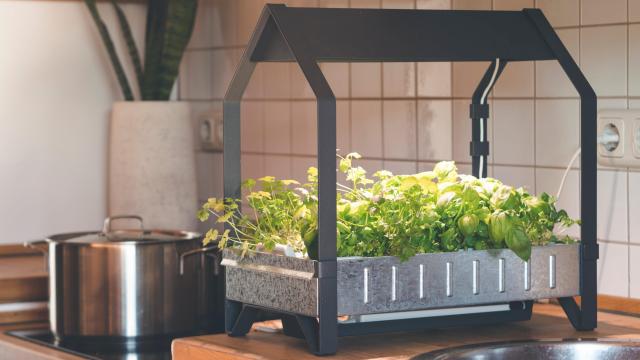Hydroponics was synonymous with growing copious amounts of weed in your apartment without much work, but these days hydroponic gardening is simply cutting-edge technology for sustainable farming. And while it seems that farming in a test tube is a bit out of touch with nature, it’s actually touted as a convenient way to grow fresh food inside your home.
You can create your own hydroponic system, or purchase pre-made kits where all you need to do is tend to the plants. It sounds easy, but how user-friendly is it? Here are the facts about hydroponic gardening and what it takes to grow one in your home.
What is hydroponics?
Without getting into too much of the science, hydroponics is the act of growing plants submerged in water without the use of soil. The nutrient-rich water and grow lights give plants everything they need to thrive while in an enclosed space. Having a controlled environment encourages rapid growth without using chemicals, uses less water than the average farm or plant, and growing indoors means you could grow fresh food in the dead of a northeastern winter.
When the world went on lockdown, interest in hydroponic gardening skyrocketed, and personally, the pandemic inspired me to learn how to grow my own food. Knowing how to grow food without soil would be a good skill to have in what felt like an apocalypse.
How to start your own DIY hydroponic garden
There are several different ways to execute hydroponic gardening. all of which require some combination of the items listed by The Spruce below:
Bucket or basin for water reservoir
Grow light (optional)
Water
Hydroponic fertiliser (dry or liquid)
Cotton or nylon cord
Growing medium
Seedling
Growing tray
Drill or screwdriver (optional)
Wick system hydroponics (beginner difficulty)
The wick system has no electronic parts, but uses a string of wicks (like a candle) to help water travel up to the plant’s roots to grow. There are no mechanical systems, which makes this the best option for apocalyptic skills building.
You would need a growing container, a basin for the water reservoir, wicks, a growing medium (a moss-like block to house the plant’s roots), and a nutrient solution. You can get most of these items online through Amazon, and it’ll cost you about $US82 ($105) at the end (about $US20 ($26) more if you purchase a grow light instead of using natural light.) The wick system works best for fast-growing plants like lettuce and herbs.
The ebb and flow method (intermediate difficulty)
A bit more complicated than the wick system, the ebb and flow option uses the power of gravity and a water pump to cycle the water in and out of the basin from the nutrient solution water reservoir below. This style is considered an intermediate’s hydroponic option, but once set up, it needs moderate attention. It’s most beneficial for those wanting to switch out plants every so often without disturbing other seedlings in the system. With the addition of a submersible pump and electronic timer, this system could cost you about $US130 ($167) (including a grow light).
Nutrient Film Technique and Aeroponic (advanced difficulty)
More complicated DIY options are the Nutrient Film Technique featuring a continuous flow of water, like the hanging Aeroponic System where plant roots grow suspended in the air. According to The Spruce, when assembled on your own, these systems could cost you upwards of $US150 ($193). These types require a lot of legwork to create, and you’re probably better off purchasing an assembled kit.
How to buy a pre-made hydroponic garden kit
Sourcing all of these components is easy enough, but assembling any type of system can be a delicate process. If you lack the patience (as I do), purchasing a manufactured kit is a faster, easier option.
On Amazon, the beginner’s hydroponic wick system is more affordable than the DIY option, costing about $US50 ($64), whereas an advanced-level Aeroponic system can cost $US599 ($770) to $US669 ($860) depending on the source of the kit. A popular aeroponic option is assembled as a sleek plant tower, with easy installation and ways to match your decor, but can run you $US499 ($642) at some retailers. Rise Gardens offers a wide variety of hydroponic systems that are self-watering and app-controlled, priced at $US279 ($359) for a personal size as a smaller option. Larger “three family-sized” indoor garden systems can cost almost $US950 ($1,222).
Kits come with all the necessary materials and detailed instructions for installation. A beginner gardener can be up and growing in no time, but you’ll have to decide if the cost is worth the convenience. As someone looking to start her planting journey, it’s safe to say hydroponics is not a total walk in the park. The various systems take a good level of commitment and money, but can be great if you’re up to the task.
Note: Not all these items are available to ship to Australia at the time of writing.

Leave a Reply
You must be logged in to post a comment.